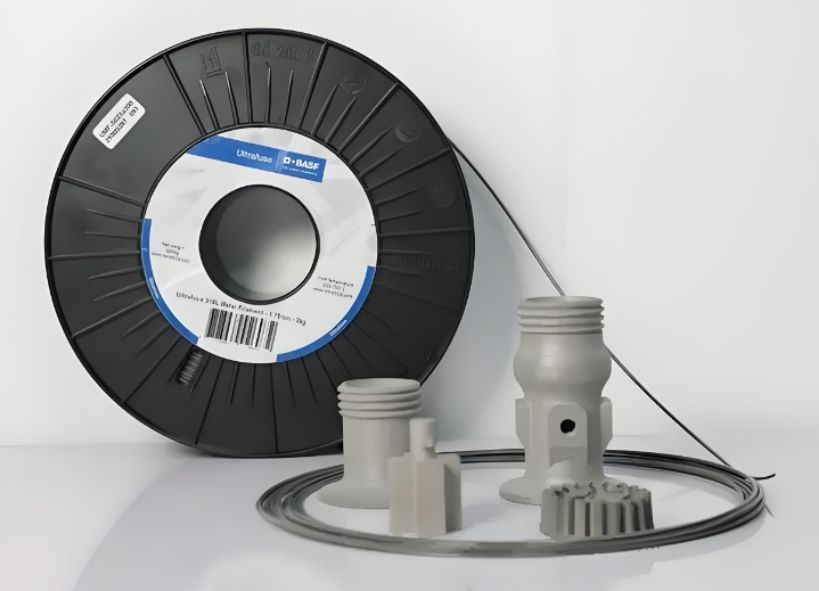
- Author
- 12 January 2026
Exploring Metal Filament 3D Printing: The Future of Additive Manufacturing
Introduction
In the ever-evolving landscape of 3D printing, metal filament 3D printing has emerged as a game-changer. Bridging the gap between traditional metalworking and modern additive manufacturing, this technology is reshaping industries from aerospace to healthcare. This blog will delve into what metal filament 3D printing is, its advantages, applications, 3D printer support metal filament, and what the future holds for this innovative technique.
What is Metal Filament 3D Printing?
Metal filament 3D printing involves using a filament composed of metal particles mixed with a binding polymer. This filament is fed into a 3D printer, where it is extruded and layered to create a desired object. The most popular filament currently on the market is BASF Ultrafuse 316L, it is a metal-polymer composite filament that can be used with standard Fused Deposition Modeling (FDM) 3D printers.
Advantages of Metal Filament 3D Printing
- Cost-Effective Production: Traditional metalworking techniques can be expensive and time-consuming. Metal filament 3D printing reduces costs by minimizing material waste and labor-intensive processes.
- Customization: Metal filament 3D printing is ideal for producing customized parts tailored to specific needs, making it invaluable for industries requiring bespoke solutions.
- Speed: Prototyping and production cycles are significantly faster, enabling quicker iterations and time-to-market.
Applications of Metal Filament 3D Printing
- Aerospace: The aerospace industry benefits from lightweight yet strong components that can withstand extreme conditions. Metal filament 3D printing allows for the production of parts with complex internal structures, reducing weight without compromising strength.
- Medical Devices: Custom implants and prosthetics can be tailored to individual patients, improving comfort and functionality. Metal filament 3D printing enables the creation of biocompatible metal parts that integrate seamlessly with the human body.
- Automotive: High-performance, durable components can be produced for automotive applications, from prototype testing to final production parts. The ability to quickly iterate designs helps in the rapid development of new automotive technologies.
- Jewelry: Jewelry designers can explore new artistic possibilities with metal filament 3D printing, creating intricate designs that would be challenging to craft by hand.
3D Printers Capable of Printing Metal Filament
1. Markforged Metal X
Overview
The Markforged Metal X is a well-known name in metal 3D printing, renowned for its user-friendly interface and robust build quality.
Key Features
- Materials: Stainless steel, tool steel, Inconel, titanium, and copper.
- Build Volume: 300 x 220 x 180 mm.
- Layer Resolution: 50 microns.
- Software: Markforged’s Eiger software simplifies the printing process with intuitive controls and real-time monitoring.
Advantages
- High precision and strong mechanical properties.
- Efficient debinding and sintering process.
- Wide range of compatible metal materials.
2. Raise3D E2
Overview
The Raise3D E2 is a versatile dual extruder 3D printer that, with appropriate modifications and settings, can handle metal filaments like BASF Ultrafuse 316L.
Key Features
- Materials: Various, including metal composite filaments.
- Build Volume: 330 x 240 x 240 mm.
- Layer Resolution: 20 microns.
- Software: IdeaMaker, with support for third-party slicing software.
Advantages
- Dual extrusion allows for printing with support materials.
- High precision and large build volume.
- Adaptable for different types of filaments.
3. Ultimaker S5
Overview
The Ultimaker S5 is a high-end FDM 3D printer known for its reliability and print quality. It can print with metal composite filaments, making it a versatile tool for prototyping and low-volume production.
Key Features
- Materials: Wide range, including metal composites.
- Build Volume: 330 x 240 x 300 mm.
- Layer Resolution: 20 microns.
- Software: Ultimaker Cura, with advanced material profiles.
Advantages
- Reliable and consistent performance.
- Large build volume and fine detail resolution.
- Extensive material compatibility.
In fact, 80% of desktop 3D printers currently available on the market can print this material, as it requires only moderate nozzle and bed temperatures. However, it’s important to note that using the printed parts directly is not recommended. Professional high-temperature annealing equipment is necessary for proper heat treatment and quality inspection. Without this step, the parts are prone to deformation and fractures due to thermal stress during use. Therefore, it is not recommended for individual users.
The Future of Metal Filament 3D Printing
The future of metal filament 3D printing looks promising as advancements continue to be made in materials, printer capabilities, and post-processing techniques. Some trends to watch include:
- Material Innovations: Ongoing research is focused on developing new metal filaments with enhanced properties, such as improved strength, conductivity, and corrosion resistance.
- Multi-Material Printing: The ability to print with multiple materials simultaneously will enable the creation of composite parts with unique properties.
- larger Scale Printing: As technology advances, we can expect to see larger 3D printers capable of producing bigger metal components, expanding the range of possible applications.
- Integration with Traditional Manufacturing: Combining 3D printing with traditional manufacturing methods will lead to hybrid processes that leverage the strengths of both approaches.
Conclusion
Metal filament 3D printing is transforming the way we think about manufacturing. Its ability to produce complex, customized, and high-performance metal parts opens up new possibilities across various industries. As the technology continues to evolve, it promises to further revolutionize the manufacturing landscape, making production more efficient, cost-effective, and versatile.
Embrace the future of manufacturing with metal filament 3D printing and stay ahead of the curve in this rapidly advancing field.


 English
English Deutsch
Deutsch Español
Español Français
Français Italiano
Italiano 日本語
日本語 Русский
Русский 中文
中文





